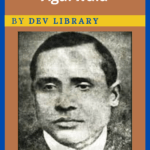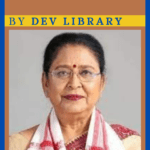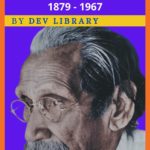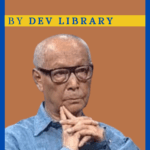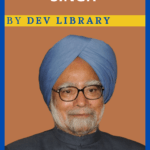Acharya Vinoba Bhave was a non-violence activist, freedom activist, social reformer and spiritual teacher. Often called Acharya (Sanskrit for teachers), he is best known for the Bhoodan Movement. An avid follower of Mahatma Gandhi, Vinoba maintained his doctrine of non-violence and equality. He dedicated his life to serving the poor and Dalits and stood up for their rights. For most of his adult life, he was a prominent philosopher centered on the spiritual beliefs of right and wrong. “Gita” has also been translated into Marathi by him called Geetai i.e., Mother Gita. Vinoba Bhave once said, “All revolutions are spiritual at source, the only purpose of all my activities is to achieve a union of hearts.” Vinoba Bhave was the first recipient of the International Ramon Magsaysay Award for Community Leadership in 1958. He was posthumously awarded the Bharat Ratna (India’s Highest Civilian Award) in 1983.

Biography of Vinoba Bhave
| Name | Vinoba Bhave[1] |
| Date of Birth | September 11, 1895 |
| Place of Birth | Gagode village, Maharashtra |
| Parents | Narahari Shambhu Rao (Father) Rukmini Devi (Mother) |
| Association | Freedom Activist, Thinker, Social Reformer |
| Movement | Indian Independence Movement; The Bhoodan Movement; Sarvodaya Movement |
| Death | November 15, 1982 |
Early Life of Vinoba Bhave
Vinayak Narahari Bhave was born on September 11, 1895 at Gagode in Maharashtra. Vinayak was the eldest son of Narahari Shambhu Rao and Rukmini Devi. He had four other siblings, three brothers and a sister. His mother Rukmini Devi was a very religious person and gave a deep sense of spirituality in Vinoba. Vinoba as a student was very fond of mathematics. He also quickly developed a spiritual conscience and was highly inspired after studying the Bhagavad Gita under the patronage of his grandfather.
Although a good student, traditional education never attracted Vinoba. He considered giving up his social life and going to the Himalayas. In other days, he considered joining the Indian Freedom Struggle. He began to travel the length of the country, learning the language Sanstra and Sanskrit as well as regional languages. He ended up in the holy city of Banaras, where he saw a part on Mahatma Gandhi, especially about his speech at Banaras Hindu University. Since then the course of his life was changed. He had burnt his entire school and college certificate on his way to Mumbai in 1916, to appear for the intermediate examination. He started in touch with Mahatma Gandhi, who invited 20-year-old Vinoba Bhave to Kochrab Ashram in Ahmedabad. Vinoba Bhave met Mahatma Gandhi on June 7, 1916 and took a resident on ashram. He dutifully participated in all the activities of ashram, leading a hard and rare life. He finally dedicated his life to various programmes formulated by Mahatma Gandhi such as khadi movement, teaching etc. Another ashram member Mama Fadke gave him the name Vinoba (a traditional Marathi adjective).
Also Read: Biography of Anna Hazare
Vinoba Bhave’s Association with Gandhi
Vinoba was attracted to Gandhi’s principles and ideologies and he considered Gandhi to be his guru from a political and spiritual point of view. He followed Gandhi’s leadership without asking any questions. Over the years, the relationship between Vinoba Bhave and Gandhi had strengthened and his involvement in the constructive agenda for the society has grown. In a letter to Vinoba, Mahatma Gandhi wrote, “I don’t know in what language to praise you.” Your love and your character attract me and your self-examination too. I am not fit to measure your value. I accept your own assumptions and take up the position of your father”. Vinoba thinks a good part of his life was spent in the ashram set up by the leader by carrying out various programmes designed by Gandhi. On April 8, 1921, under the guidance of Mahatma Gandhi, Vinoba Bhave went to Wardha to take charge of the Gandhi Ashram there. During his stay in Wardha, Bhave had also taken out a Marathi monthly name ‘Maharashtra Dharma’ in Marathi, which had his essays on the Upanishads. Later on this monthly became weekly and continued for three years. His political ideologies for achieving independence were directed towards the principle of peaceful non-cooperation. He participated in all political programmes designed by Gandhi. He believed in Gandhiji’s social beliefs such as equality between Indian and different religions.
Vinoba Bhave’s role in Freedom Struggle
Under the influence of Mahatma Gandhi, Vinoba bhava also got involved in the Indian freedom struggle. He participated in the non-cooperation movement and especially the call for the use of indigenous products instead of foreign imports. He boycotted foreign clothes and and took the spinning wheel and urged others to do so, leading to mass production of clothes. His involvement with Gandhi’s constructive programmes related to Khadi, village industries, new education, senitation, and hygiene also kept on increasing. In 1925, he was sent by Gandhi to Vaikom, Kerala to supervise the entry of Harijans to the temple.
Bhave was arrested several times dueing the 1920s and 1930s and served a five year jail sentence in the 1940s for conspiracy against British rule. The jails for Bhave had become the places of reading and writing. He wrote Ishavasyavritti and Sthitaprajna Darshan in jail. There, he explained various topics of ‘Bhagavad Gita’ in Marathi to fellow prisoners. All the lectures he gave on Gita were collected in Dulia jail and later published as books.
Until 1940, Vinoba Bhave was known only to those around him. Mahatma Gandhi issued a statement on October 5, 1940 introducing Bhave to the nation. He was also chosen by Gandhiji himself as the first personal satyagrahi (a person standing for truth).
Social Work
Vinoba thought he worked tirelessly towards eliminating social evils like inequality. His aim was to establish the kind of society gandhi envisioned in independent India. He adopted the word Sarvodaya from Gandhi which simply means “progress for all”. Under him, the Sarvodaya Movement implemented various programmes in the 1950s, the main of which is the Bhoodan Movement.
Bhoodan Movement
In 1951, Vinoba Bhave started a peace march on foot through the violent areas of Telangana. The movement started on April 18, 1951, at Pochampally village, after interacting with 80 Harijan families. He walked all across India asking people with land to consider hime one of their sons and so gave him one-sixth of their land which he then distributed to landless poor. Vinoba Bhave asked the landlords of the village to come forward and save the harijans. To everyone’s surprise, a landlord got up and offered the required land. This incident added a new chapter to the history of renunciation and non-violence. This was the beginning of the Bhoodan (gift of land) movement. The movement continued for thirteen years and Vinoba travelled the length and width of the country, with a total distance of 58741 km. He succeeded in collecting about 4.4 million acres of land, of which about 1.3 million were distributed among poor landless farmers. The movement drew praise from all over the world and was lauded as the only test of his kind to incited voluntary social justice. Non-violence and compassion is a hallmark of his philosophy, he also campaigned against the slaughtering of cows. Bhave said, “I have walked all over India for 13 years. In the backdrop of enduring perpetuity of my life’s work, I have established 6 ashrams.”
Religious Work
Vinoba was greatly influenced by the Bhagavad Gita and his thoughts and efforts were based on the doctrine of the holy book. He set up several ashrams to promote a simple lifestyle, without luxury. He established the Brahma Vidya Mandir, a small community for women, in 1959 with the aim of self-reliance in the model of Mahatma Gandhi’s education.
Literary Work
During his lifetime he wrote several books, most of which were based on spiritual themes. Apart from English and Sanskrit, he had an excellent command of several languages including Indian regional languages like Marathi, Telugu, Gujarati, Kannada, Hindi, Urdu etc. Bhave was an innovative social reformer. He called “Kannada” script the “Queen of World Scripts” (Vishwa Lipigala Raani). He wrote brief introductions to, and criticisms of, several religious and philosophical works like the Bhagavad Gita, works of Adil Shankaracharya, the Bible and Quran. His views of Dnyaneshwar’s poetry and works by other Marathi saints is quite brilliant and testimony to the breadth of his intellect. He found the content of Sanskrit scriptures to be translated into different common languages and readable to the public. Some of the books written by him are Swarajya Sastra, Gita Pravasana, Tisree Shakti or 3rd Shakti, The essence of Quran, The essence of Christan teachings etc.
Death
Vinoba fell seriously ill in November 1982 and refused to take any food and medicine in his last days. The great social reformer died on November 15, 1982.
Awards & Recognition of Vinoba Bhave
In 1958 Bhave was the first recipient of the international Ramon Magsaysay Award for Community Leadership. He was posthumously awarded the Bharat Ratna in 1983. Vinoba Bhave, The Man, a documentary film on the social-reformer directed by Vishram Bedekar was released in 1963. It was produced by Government of India’s Films Division.
Conclusion
Popular with his social work, literary work, Vinoba Bhave is a role model for the country. His main aim was to engage in village services for the benefit of the Indian people. As a result, he became a skilled farmer, spinner and weaver. Many of these activities were later included in several of his plans for the moral and spiritual advancement of all mankind. A freedom fighter and social reformer, he was posthumously honoured with the title Bharat Ratna for his work on the progress of the people of his country, known for his Bhoodan Movement.
FAQ
1. When and where was Vhinoba Bhave born?
Ans: Vinoba Bhabe was born on September 11, 1895 at Gagode village, Maharashtra.
2. Who is known as National teacher of India?
Ans: Vinayak Narahari Bhave.
3. With what movement Vinoba Bhave was associated with?
Ans: Bhoodan Movement.
4. When did Bhave was awarded with Bharat Ratna?
Ans: Bhave was awarded with Bharat Ratna in 1983.
5. Why was Vinoba Bhave awarded with Bharat Ratna?
Ans: He was posthumously honoured with the title Bharat Ratna for his work on the progress of the people of his country, known for his Bhoodan Movement.
6. When did Vinoba Bhave died?
Ans: Vinoba Bhave died on November 15, 1982 after suffering from serious illness.

Hi, I’m Dev Kirtonia, Founder & CEO of Dev Library. A website that provides all SCERT, NCERT 3 to 12, and BA, B.com, B.Sc, and Computer Science with Post Graduate Notes & Suggestions, Novel, eBooks, Biography, Quotes, Study Materials, and more.


